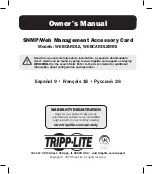
Basic Home Station VDSL2 P8701T User’s Guide
199
C
H A P T E R
1 5
Diagnostic
15.1 Overview
The Diagnostic screens display information to help you identify problems with the VDSL Router.
The route between a CO VDSL switch and one of its CPE may go through switches owned by
independent organizations. A connectivity fault point generally takes time to discover and impacts
subscriber’s network access. In order to eliminate the management and maintenance efforts, IEEE
802.1ag is a Connectivity Fault Management (CFM) specification which allows network
administrators to identify and manage connection faults. Through discovery and verification of the
path, CFM can detect, analyze and isolate connectivity faults in bridged LANs.
15.1.1 What You Can Do in this Chapter
• The Diagnostics screen lets you test the VDSL Router’s connections (
• The Fault Management screen lets you perform CFM actions (
).
15.2 What You Need to Know
The following terms and concepts may help as you read through this chapter.
How CFM Works
A Maintenance Association (MA) defines a VLAN and associated Maintenance End Point (MEP) ports
on the device under a Maintenance Domain (MD) level. An MEP port has the ability to send
Connectivity Check Messages (CCMs) and get other MEP ports information from neighbor devices’
CCMs within an MA.
CFM provides two tests to discover connectivity faults.
• Loopback test - checks if the MEP port receives its Loop Back Response (LBR) from its target
after it sends the Loop Back Message (LBM). If no response is received, there might be a
connectivity fault between them.
• Link trace test - provides additional connectivity fault analysis to get more information on where
the fault is. If an MEP port does not respond to the source MEP, this may indicate a fault.
Administrators can take further action to check and resume services from the fault according to
the line connectivity status report.
Summary of Contents for P8701T
Page 10: ...Table of Contents Basic Home Station VDSL2 P8701T User s Guide 10...
Page 11: ...11 PART I User s Guide...
Page 12: ...12...
Page 18: ...Chapter 1 Introducing the VDSL Router Basic Home Station VDSL2 P8701T User s Guide 18...
Page 59: ...59 PART II Technical Reference...
Page 60: ...60...
Page 118: ...Chapter 6 Network Address Translation NAT Basic Home Station VDSL2 P8701T User s Guide 118...
Page 148: ...Chapter 10 DNS Setup Basic Home Station VDSL2 P8701T User s Guide 148...
Page 158: ...Chapter 11 UPnP Basic Home Station VDSL2 P8701T User s Guide 158...
Page 166: ...Chapter 12 USB Services Basic Home Station VDSL2 P8701T User s Guide 166...
Page 198: ...Chapter 14 Wireless Basic Home Station VDSL2 P8701T User s Guide 198...
Page 202: ...Chapter 15 Diagnostic Basic Home Station VDSL2 P8701T User s Guide 202...
Page 206: ...Chapter 16 Settings Basic Home Station VDSL2 P8701T User s Guide 206...
Page 210: ...Chapter 17 Log Basic Home Station VDSL2 P8701T User s Guide 210...
Page 214: ...Chapter 18 TR 069 Client Basic Home Station VDSL2 P8701T User s Guide 214...
Page 216: ...Chapter 19 Internet Time Basic Home Station VDSL2 P8701T User s Guide 216...
Page 218: ...Chapter 20 Access Control Basic Home Station VDSL2 P8701T User s Guide 218...
Page 222: ...Chapter 22 Reboot Basic Home Station VDSL2 P8701T User s Guide 222...
Page 230: ...Chapter 23 Troubleshooting Basic Home Station VDSL2 P8701T User s Guide 230...
Page 234: ...Appendix A Legal Information Basic Home Station VDSL2 P8701T User s Guide 234...
Page 240: ...Index Basic Home Station VDSL2 P8701T User s Guide 240...
















































